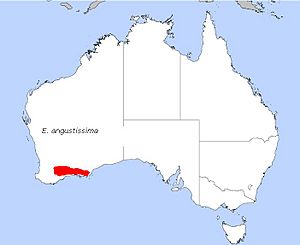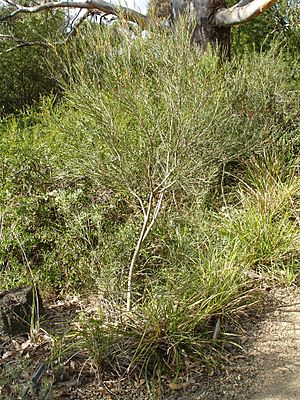Narrow-leaved Mallee facts for kids
Quick facts for kids Narrow-leaved mallee |
|
|---|---|
 |
|
| Scientific classification | |
| Genus: |
Eucalyptus
|
| Species: |
angustissima
|
 |
|
| E. angustissima, field distribution | |
The Narrow-leaved Mallee, also known by its scientific name Eucalyptus angustissima, is a special type of small tree. It grows naturally in the southern parts of Western Australia. You can find these trees scattered along the coast and in areas just inland. This plant is endemic to Western Australia, which means it grows nowhere else in the world!
What it Looks Like
This eucalyptus is a type of plant called a mallee. A mallee is a plant that has many stems growing from a single underground base. The Narrow-leaved Mallee usually grows to be about 1 to 4 metres tall, which is like a small tree or a large bush.
Its bark is smooth and often looks mottled, meaning it has patches of different colours like grey, white, or light grey-brown.
The leaves of this plant change as it grows. Young leaves are about 4.5 to 8 centimetres long and very thin, only about 0.3 to 0.4 centimetres wide. The adult leaves are even longer and narrower, reaching 7 to 11.5 centimetres in length but only 0.15 to 0.3 centimetres wide! They are truly "narrow-leaved."
The Narrow-leaved Mallee produces creamy-white flowers. These flowers grow in small groups of up to seven buds. You can see these beautiful flowers between August and January. After the flowers, the plant forms small, round fruits that are about 0.5 to 0.8 centimetres wide. The top part of the tree, called the crown, is often very thick and bushy, which can sometimes make it hard to tell it's a eucalyptus at first glance.
Scientists have identified two main types, or subspecies, of the Narrow-leaved Mallee.
Where it Grows
You can often find the Narrow-leaved Mallee growing in interesting places. It likes flat areas that are a bit salty, or around salt lakes. It also grows on sandhills. This tough plant can grow in different types of soil, including white or grey sands, clay, and loam. It can even handle some salty soils! It thrives in scrubland and woodland areas.
How it was Discovered
The Narrow-leaved Mallee was first officially described by a famous botanist named Ferdinand von Mueller. He wrote about it in 1863 in his collection of papers called Fragmenta phytographiae Australiae. The samples he used to describe the plant were collected by George Maxwell near a place called Point Maxwell.
Later, in 1992, two other scientists, L.A.S. Johnson and K.D. Hill, described one of the subspecies. They wrote about it in a science journal called Telopea. Their samples were collected near Lake Chinocup.


